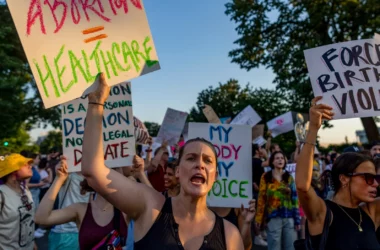The reception of migrants continues to be a polarizing issue across the Western world, and Coolock, a suburb of Dublin, Ireland, has become a recent flashpoint. On July 15, 2024, tensions over the use of the former Crown Paints factory site to house migrants escalated into violent clashes between protesters and police. The conflict resulted in the burning of a police vehicle and numerous arrests.
Context of the Protest
Since March, a protest camp has been set up outside the former Crown Paints factory site on Malahide Road, a major thoroughfare north of Dublin. Protesters have built small wooden shacks and displayed banners with slogans such as “Coolock Says No,” opposing the plan to convert a large warehouse on the site into housing for International Protection Seekers. The demonstrations have included marches and occasional disruptions to traffic, sometimes even on horseback.
The Clashes on July 15, 2024
The unrest began early Monday morning when a protester posted a video on TikTok at 3:51 a.m., showing numerous gardaí (Irish police) at the entrance of the site. He mentioned a clearance order had been received and that garda vehicles were positioned at key points on Malahide Road. Shortly afterwards, another protester recorded footage of the site, which was surrounded by fences, with security guards and a digger demolishing the wooden shacks.
As the morning progressed, more protesters arrived. By 7:30 a.m., the previously expelled protester had returned, calling for reinforcements. By 8:12 a.m., about fifteen protesters had gathered, gradually increasing in number, directing their anger towards a group of male migrants at the site entrance, shouting insults and physical threats. Between 9:30 and 10:30 a.m., protesters dragged mattresses from the site entrance and set them on fire. Shortly afterward, the excavator was engulfed in flames.
With the arrival of the gardaí, tensions escalated. By 11 a.m., about twenty gardaí were on the scene, accompanied by fire trucks and ambulances. Local politicians, including Kevin Coyle and Stephen Redmond, were present, posting updates and videos from the site on their social media accounts.
In the afternoon, tensions reached a peak. Protesters used damaged fences to push against the garda line, leading to the intervention of the Public Order Unit, which used pepper spray and made arrests. Protesters set fire to large commercial bins and threw fireworks at the gardaí.
The End of the Day
As calls for a protest rally spread on social media, nationalist political figures such as Derek Blighe and Councillor Glen Moore arrived in Coolock. By 7:00 p.m., footage still showed clashes, with some youths vandalizing and setting fire to a garda vehicle, resulting in a dozen arrests. Councillors Pepper and Malachy Steenson were seen trying to calm the tensions, but to no avail.
The day’s events marked a significant escalation in the ongoing protest, highlighting the deep divisions and high stakes surrounding the issue of migrant reception in Dublin.
Broader Context and Trends
The conflict at the former Crown Paints factory site is part of a broader trend of violence and arson targeting buildings earmarked for refugees. Over 20 incidents of arson have been reported at such sites in the past year, with notable examples including fires in Fethard, Sandyford, Lanesborough, Tallaght, Leixlip, and Newtownmountkennedy.
The plan to house migrants in Coolock is part of a broader government strategy. In 2022, former Justice Minister Helen McEntee approved a pathway to citizenship for 17,000 undocumented migrants and their families under a “once-in-a-generation” scheme. Ireland is on track to accept 20,000 asylum seekers by the end of this year, with over 6,000 applications filed by mid-April.
The situation in Coolock reflects broader global tensions over immigration policies and the challenges of integrating large numbers of migrants into local communities. Recent polls indicate that 63% of the Irish population now support stricter immigration policies. With a population of five million, Ireland’s proportional level of migration is similar to that of Germany.
While Dublin’s vibrant core remains a showcase of architectural prowess and global business hubs, challenges persist on its peripheries, where social tensions over housing, migration, and community integration manifest prominently. The Coolock protests serve as a poignant reminder of these challenges, prompting ongoing debates on policy, community cohesion, and the humanitarian responsibilities of nations facing influxes of displaced populations.
As Ireland navigates these complexities, the Coolock incident underscores the imperative for balanced dialogue and effective policy responses to address both humanitarian needs and community concerns in a rapidly changing world.








